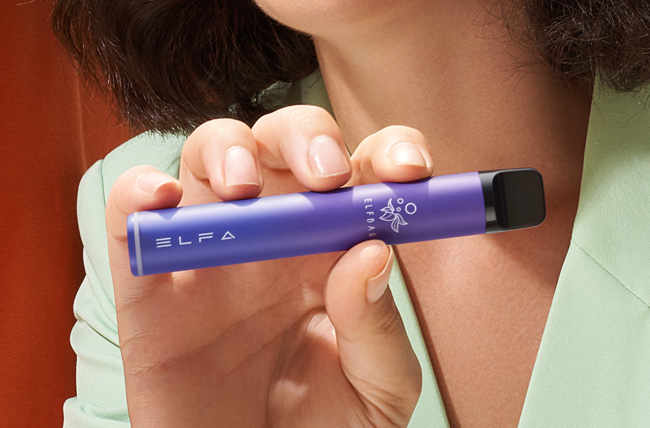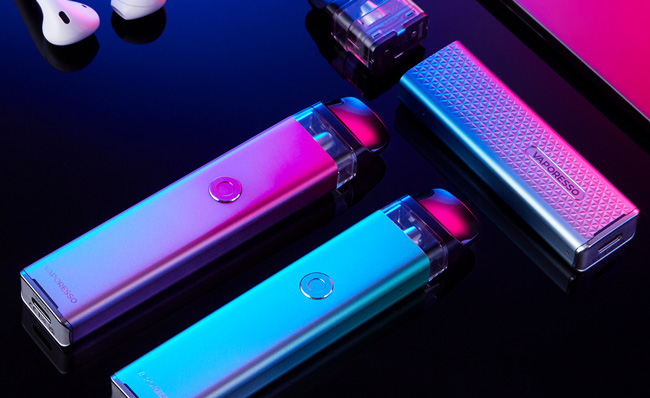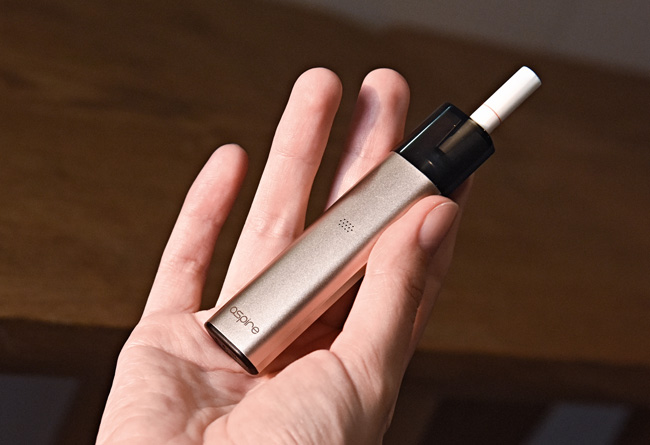
Updated: December 2023
“You’ve got to try this again, Julia!” I said to our accountant.
She’s been smoking for decades, and occasionally mutters about quitting. I’d been trying her on various vape pens and devices trying to get her to switch. This time, I was trying her on an Aspire Mini Nautilus and iStick, hoping that a more powerful e-cig would do the job.
“Oh go on then.” Julia lifted it to her mouth and inhaled.
“It’s not working!”
“Just press the button and inhale.”
Julia did as I asked, only to burst into a fit of coughing.
“Here you are!” she gasped in between coughs. “You can have that back!”
Julia’s not the only one. Plenty of people cough when they first vape. I suspect many give up because of it.
Fortunately, it’s often easy to prevent coughing by changing your inhale technique, your vape pen or your vape juice.
Let’s take a deeper look...
Contents
Julia’s not the only one who coughs when vaping.
In fact, when we surveyed 600 vapers, almost 57% of them said they coughed when using a vape pen for the first time.

Research by scientists backs this up, suggesting that the most common side effect experienced by first-time vapers was a cough and sore throat. For example, Polosa et al found that 32.4% of vapers reported coughing when they first started.
For most vapers, coughing when vaping is a temporary effect.
While almost 57% said they coughed when they first vaped, 93% of them no longer have a problem.

For those interested, 92% had been vaping for more than 10 weeks, with just 1% of those surveyed vaping for 0-1 weeks.
We All Cough Now and Then
I coughed a little when I started vaping, but I was far too excited at the world of possibilities in front of me for it to be an issue.
I’ve found that it takes about a day to acclimatise to a harsher juice, so I can’t imagine that the cough should be an ongoing issue. I’m sure we all still cough every now and then when we take too big a hit though!
Max from GetVape.co.uk
Technique used when vaping
According to nicotine expert Dr Jacques Le Houzec, many smokers are very tentative when they first use an e-cigarette.
As a result:
- they inhale for a short period of time
- they inhale a lot of air with the vapour.
Experienced vapers don’t inhale air with their vapour. They also take longer, slower inhales.
This difference could explain why people cough when they first vape, but not when they are experienced vapers.
Our survey seems to suggest technique makes a difference for at least some vapers. Although many respondents (40.58%) were unsure or couldn’t remember whether changing technique helped, almost 30% felt it did help:
Jacques agrees. He finds that he can get any smoker to vape without coughing by getting them to take a long drag without breathing in extra air.Learn more about vape inhaling technique.
Ingredients in vapour
Most vapers will probably tell you we cough because of propylene glycol (PG).
Based on a very rough estimate (put together by Chris Price of ECigarette Politics based on an analysis of forum posts), around 10% of the population is sensitive to propylene glycol. (A much smaller proportion is allergic to it ).
In addition, Professor Polosa told me there may be other elements in vapour that cause vapers to cough:
we cannot discount the possibility of other unknown ingredients, contaminants, by-products in the e-vapour causing similar irritant effects.
But this raises a question.
Why do vapers cough when they first use e-cigarettes, but not after sustained use?
No-one seems to have the answer at the moment, but one possible reason is that your body gets used to these chemicals.
Lack of anaesthetics
Chris Price believes that tobacco smoke contains ingredients that stop smokers from coughing. Chris told me:
Essentially, this is why you can breathe in tobacco smoke when you can’t breathe in bonfire smoke too well, when they are basically the same thing: burning plant matter…. Some of the 9,600 ingredients identified to date are in there to make the smoke smoother, less irritating, and to prevent coughing.
A 2007 study by Rabinoff et al makes references to anaesthetics in tobacco smoke. They also referenced other botanical and chemical additives which could “reduce, mask, or prevent smokers’ awareness of the adverse symptoms caused by smoking”.
The absence of anaesthetics and antitussives in vaping could help explain why you cough when you first try vaping, even if you don’t cough when you smoke.
When you smoke, you slowly destroy tiny hair-like projections on your respiratory tract called cilia. When you stop smoking, these slowly grow back.
A by-product of the hairs growing back is coughing - just one of many side effects you can experience when you stop smoking (for a more complete list, see here: 7 Quit Smoking Side Effects: The Essential Guide for New Vapers and Quitters).
 Cilia in the lungs. Via http://en.wikipedia.org/wiki/File:Bronchiolar_epithelium_3_-_SEM.jpg
Cilia in the lungs. Via http://en.wikipedia.org/wiki/File:Bronchiolar_epithelium_3_-_SEM.jpg
Some bloggers have speculated that this regrowth of cilia could be why new vapers cough.
This might explain why some new vapers have a recurring cough when switching to vaping. However, it doesn’t explain why smokers cough when they vape their first e-cigarette.
Update: The speculation has now been confirmed by a study by Polosa et al. The study found that after switching to vape, cilia completely regrows. As it does so, it starts moving excess mucous out of the airway passages, causing coughing in the process. Polosa describes this as a 'purposeful/functional cough".
For more information, you can see a summary of the study and an interview with the lead author here: Vaping Can Restore Lung Defence Finds New Study.
Nicotine strength & throat hit
If you’re an experienced vaper and you’ve tried a zero nicotine vape juice, you’ll have noticed a reduced throat hit.
A higher nicotine level seems to lead to a harsher vape and an increased likelihood of coughing.On the other hand, some people need a high nicotine level in order to successfully switch to e-cigarettes.
Learn more: The Vaper's Guide to Throat Hit
Device used
The device you use can also contribute to coughing. In fact, many users cough when they first switch to a sub-ohm device.
So if coughing is an issue for you, it may be worth using a more basic device when you start off. Again, you do need to balance this with research that shows cigarette smokers are more likely to successfully switch to electronic cigarettes with more advanced devices. (See Polosa et al: Success rates with nicotine personal vaporizers: a prospective 6-month pilot study of smokers not intending to quit.)
This is probably because they deliver more nicotine more quickly than basic devices, as the graph below shows:
Finding the Right Device and E-Liquid Was Key
I've been a smoker for nearly 15 years. When I first started using electronic cigarettes, I continued to smoke for nearly 2 years. I'll be 1 month smoke free next Wednesday, so I'm still at the start of my journey. It has not been easy, but it's getting easier.
For me, finding the right combination for e-liquid and hardware was key. Working for ECigarettedirect, I'm lucky that there's never a shortage of vaping devices around me. But it was only when I started sub-ohming with a box mod and an Aspire Atlantis Clearomiser that I could eliminate smoking 100%.
I always enjoyed smoking, but not the side effects; the breath, the stinky clothes, the breathlessness. I still love the smell of cigarette smoke, but if I have my e-cig with me, I know I'll be ok.
Tom - ECigaretteDirect Staff
Dehydration
Both propylene glycol (PG) and vegetable glycerine (VG) attract water, which helps make the clouds of vapour that you see when exhale.
A minor side of this can be dehydration and occasionally a sore or dry throat, which may contribute to coughing.
I Stopped Coughing After A Few Days
I remember it was both a familiar and alien sensation. Unlike smoking, there wasn't any warmth to the vape; and there was a "catch" on the inhale whether from the sensation or the flavour I can't be 100% sure. It was definitely a unique experience, but the taste from the vape convinced me to keep at it. That I think was the most surprising thing, the taste. I did cough, almost immediately after each vape for the first dozen or so then less regularly for a few days then it stopped. Unless I'm a complete moron and don't leave a fresh tank to wick properly!
I knew that the cough reflex was my body trying to clean itself so didn't really pay it too much attention, especially as I had been coughing a lot with the recent cigarette binge, but the sporadic coughing didn't make it difficult to vape.
Paul Barnes fdm.ukvaping.com
1. Experiment with techniques
I’ve always assumed that a ‘Mouth-to-Lung inhale’ would be less likely to lead to coughing. But that’s not always the case, as this comment by Brown Eyed Pea on Reddit shows:
I used to [cough] (and still do sometimes) with Mouth-to-Lung inhales, never with Direct-Lung inhales for some reason
So it’s important to experiment with technique to find the right one for you. You can find a full overview of vape inhale techniques here.
I’d love to know which techniques work
2. Change VG:PG ratio
If you continue to experience a cough when you vape, you could change the VG:PG ratio.

Most vape juices are made up of PG (propylene glycol) and VG (vegetable glycerine). VG is smoother, and many people who use high-powered vape mods find it reduces or eliminates coughing.Want to know more? See The Vaper’s Guide to PG Allergy: Sensitivities, Allergies and What Vapers Can Do About It.
3. Experiment with nicotine levels
We’ve seen that nicotine can affect the throat hit that you get. So if coughing is an issue, it may be worth temporarily reducing the nicotine that you use.
However, remember that scientists tell us the harm with smoking comes from the smoke, not the nicotine. So once you are used to vaping, it might be worth increasing the nicotine level if it helps you stay off tobacco cigarettes.
4. Experiment with nicotine salts
Until nicotine salts came along, it was almost impossible to vape high nicotine vape juice because the throat hit was too harsh.
Nicotine salts changed this. By using the natural form of nicotine found in tobacco, the throat hit was softened, enabling vapers to use higher nicotine levels without leaving a harsh feeling at the back of the throat.
If you find the throat hit from vaping irritating, or if it is making you cough, it’s well worth trying nicotine salts.
Some of our favourite options here are the HEXA Pro and Elf Bar Elfa Pro- closed pod systems that combine regular vape juice and nicotine salts for a hit that is very close to that of a cigarette.
For those with open systems, check out this range of 10ml nicotine salts. But do note, they are best used in low-powered devices and pod systems, not high-powered mods!

5. Drink water
We've seen that PG and VG can cause minor dehydration, but you can tackle this by simply drinking more water.
6. Use a lower-wattage device
One reason people cough is because they are getting too much vapour. You can combat that by using a lower-powered device such as a vape starter kit.
If you need a strong nicotine hit without wanting to cough too much, the Vaporesso Xros 3 Mini combined with nicotine salts is the perfect solution. Nicotine salts deliver a stronger nicotine hit without the harsh throat hit often associated with high nicotine levels.

Another alternative is the Aspire Vilter. This uses soft tip, cigarette-style filters which produce a thin stream of vapour with a soft throat hit.

If you want to be able to change the wattage of your device (increase or decrease the power), you might want to try the Innokin Endura T22 Pro. The experience is similar to smoking a cigarette, it comes with a long-lasting battery and is easy to use.
7. Change the speed of inhale
lan Miller finds that inhaling really slowly can lead to coughing, as their is not enough air hitting the coil in your e-cigarette. By experimenting with the speed you inhale, you may be able to reduce coughing.
8. Change the speed of exhale
Celeb Fawkes finds that you can reduce the chance of coughing by using a slow, controlled exhale.
9. Add a drop of menthol
Edward suggests adding a drop of menthol e-liquid to your e-juice.
If you are thinking of quitting e-cigs at the first hurdle, it might be worth considering the positive side effects of vaping.
While most reported side effects are both minor and temporary, research shows that the positive effects of vaping can be huge, especially if you switch 100% to electronic cigarettes. Here are just some of those found by scientists:
For the full story, click below.
Did you cough when you first vaped? Share your story below!
Farsalinos et al: Characteristics, Perceived Side Effects and Benefits of Electronic Cigarette Use: A Worldwide Survey of More than 19,000 Consumers Int. J. Environ. Res. Public Health 2014, 11(4), 4356-4373; https://doi.org/10.3390/ijerph110404356
Polosa et al: Effect of an electronic nicotine delivery device (e-Cigarette) on smoking reduction and cessation: a prospective 6-month pilot study BMC Public Health 201111:786 https://doi.org/10.1186/1471-2458-11-786
Polosa et al: Success rates with nicotine personal vaporizers: a prospective 6-month pilot study of smokers not intending to quit BMC Public Health 2014, 14:1159 Int. J. Environ. Res. Public Health 2014, 11(4), 4356-4373; https://doi.org/10.3390/ijerph110404356
Rabinoff et al: Pharmacological and Chemical Effects of Cigarette Additives, Am J Public Health. 2007 November; 97(11): 1981–1991, doi: 10.2105/AJPH.2005.078014
Stratton K, Shetty P, Wallace R, et al: Clearing the smoke: the science base for tobacco harm reduction—executive summary Tobacco Control 2001;10:189-195., http://dx.doi.org/10.1136/tc.10.2.189



